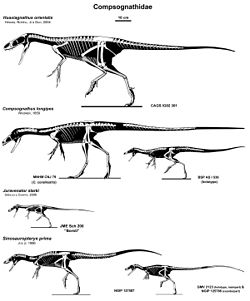
Back Compsognathidae Afrikaans Compsognàtids Catalan Compsognathidae CEB Compsognathidae Czech Compsognathidae German Compsognathidae Spanish Compsognathidae Basque آراستهآروارگان Persian Siroleuat Finnish Compsognathidae French
| Compsognathidae | |||
|---|---|---|---|

| |||
| Compsognathid skeletons to scale | |||
| Scientific classification | |||
| Domain: | Eukaryota | ||
| Kingdom: | Animalia | ||
| Phylum: | Chordata | ||
| Clade: | Dinosauria | ||
| Clade: | Saurischia | ||
| Clade: | Theropoda | ||
| Clade: | Neocoelurosauria | ||
| Family: | †Compsognathidae Cope, 1871 | ||
| Type species | |||
| †Compsognathus longipes Wagner, 1861
| |||
| Genera[2][3] | |||
| |||
| Synonyms | |||
| |||
Compsognathidae is a family of coelurosaurian theropod dinosaurs. Compsognathids were small carnivores, generally conservative in form, hailing from the Jurassic and Cretaceous Periods. The bird-like features of these species, along with other dinosaurs such as Archaeopteryx inspired the idea for the connection between dinosaur reptiles and modern-day avian species.[4] Compsognathid fossils preserve diverse integument — skin impressions are known from four genera commonly placed in the group, Compsognathus, Sinosauropteryx, Sinocalliopteryx and Juravenator.[5] While the latter three show evidence of a covering of some of the earliest primitive feathers over much of the body, Juravenator and Compsognathus also show evidence of scales on the tail or hind legs. "Ubirajara jubatus", informally described in 2020, had elaborate integumentary structures on its back and shoulders superficially similar to the display feathers of a standardwing bird-of-paradise, and unlike any other non-avian dinosaur currently described.
The first member of the group, Compsognathus, was discovered in 1861, after Johann A. Wagner published his description of the taxon.[6][7][8] The family was created by Edward Drinker Cope in 1875.[9] This classification was accepted by Othniel Charles Marsh in 1882, and added to the Coelurosauria clade by Friedrich von Huene in 1914 after additional fossils had been found.[6] With further discoveries, fossils have been uncovered across three different continents, in Asia,[5][6][7][8][10] Europe,[11] and South America.[7][9] Assignment to Compsognathidae is usually determined through examination of the metacarpal, which is used to separate Compsognathidae from other dinosaurs.[12] However, classification is still complicated due to similarities to the body of several other theropod dinosaurs, as well as the lack of unifying, diagnostic features that are shared by all compsognathids.[9][13] Some authors have proposed that Compsognathidae is not a monophyletic group, and at least some compsognathids represent juvenile specimens of larger tetanuran theropods, such as carnosaurs and tyrannosaurs.[14][15][16]
- ^ J. N. Choiniere, J. M. Clark, C. A. Forster and X. Xu. 2010. A basal coelurosaur (Dinosauria: Theropoda) from the Late Jurassic (Oxfordian) of the Shishugou Formation in Wucaiwan, People's Republic of China. Journal of Vertebrate Paleontology 30(6):1773-1796
- ^ Hendrickx, C., Hartman, S.A., & Mateus, O. (2015). An Overview of Non- Avian Theropod Discoveries and Classification. PalArch’s Journal of Vertebrate Palaeontology, 12(1): 1-73.
- ^ Hartman, Scott; Mortimer, Mickey; Wahl, William R.; Lomax, Dean R.; Lippincott, Jessica; Lovelace, David M. (2019). "A new paravian dinosaur from the Late Jurassic of North America supports a late acquisition of avian flight". PeerJ. 7: e7247. doi:10.7717/peerj.7247. PMC 6626525. PMID 31333906.
- ^ Etnier, Michael A. "Neptune's Ark: From Ichthyosaurs to Orcas." (2008): 25.
- ^ a b Xu, Xing. "Palaeontology: Scales, feathers and dinosaurs." Nature 440.7082 (2006): 287-288.
- ^ a b c Peyer, Karin. "A reconsideration of Compsognathus from the Upper Tithonian of Canjuers, southeastern France." Journal of vertebrate Paleontology 26.4 (2006): 879-896.
- ^ a b c Sales, Marcos AF, Paulo Cascon, and Cesar L. Schultz. "Note on the paleobiogeography of Compsognathidae (Dinosauria: Theropoda) and its paleoecological implications." Anais da Academia Brasileira de Ciências 86.1 (2014): 127-134.
- ^ a b Wagner, A. "Neue Beiträge zur Kenntnis der urweltlichen Fauna des lithographischen Schiefers; V. Compsognathus longipes Wagner." Abhandlungen der Bayerischen Akademie der Wissenschaften 9 (1861): 30-38.
- ^ a b c Naish, D.; Martill, David M.; Frey, Eberhard (2004). "Ecology, systematics and biogeographical relationships of dinosaurs, including a new theropod, from the Santana Formation (?Albian, Early Cretaceous) of Brazil" (PDF). Historical Biology. 16 (2–4): 57–70. CiteSeerX 10.1.1.394.9219. doi:10.1080/08912960410001674200. S2CID 18592288.
- ^ Shu'an, Ji, et al. "New material of Sinosauropteryx (Theropoda: Compsognathidae) from western Liaoning, China." Acta Geologica Sinica (English Edition) 81.2 (2007): 177-182.
- ^ Dal Sasso C., Maganuco S. "Scipionyx samniticus (Theropoda: Compsognathidae) from the Lower Cretaceous of Italy: osteology, ontogenetic assessment, phylogeny, soft tissue anatomy, taphonomy and palaeobiology." Memorie, XXXVI-I (2011): 1-283.
- ^ Gishlick, Alan D., and Jacques A. Gauthier. "On the manual morphology of Compsognathus longipes and its bearing on the diagnosis of Compsognathidae." Zoological Journal of the Linnean Society 149.4 (2007): 569-581.
- ^ Brett-Surman, Michael K., Thomas R. Holtz, and James O. Farlow, eds. The complete dinosaur. Indiana University Press, 2012 pp 360.
- ^ Cau, Andrea (2021). "Comments on the Mesozoic theropod dinosaurs from Italy". Atti della Società dei Naturalisti e Matematici di Modena. 152: 81–95.
- ^ Cau A. (2024). A Unified Framework for Predatory Dinosaur Macroevolution. Bollettino della Società Paleontologica Italiana, 63(1): 1-19.
- ^ Foth, Christian; Haug, Carolin; Haug, Joachim T.; Tischlinger, Helmut; Rauhut, Oliver W. M. (2020), Foth, Christian; Rauhut, Oliver W. M. (eds.), "Two of a Feather: A Comparison of the Preserved Integument in the Juvenile Theropod Dinosaurs Sciurumimus and Juravenator from the Kimmeridgian Torleite Formation of Southern Germany", The Evolution of Feathers, Cham: Springer International Publishing, pp. 79–101, doi:10.1007/978-3-030-27223-4_6, ISBN 978-3-030-27222-7, retrieved 2024-04-18